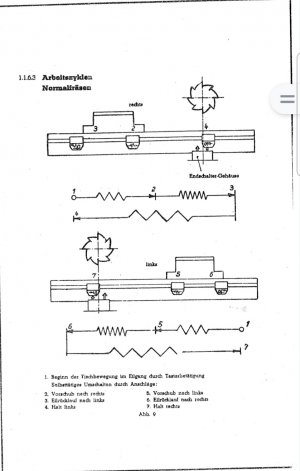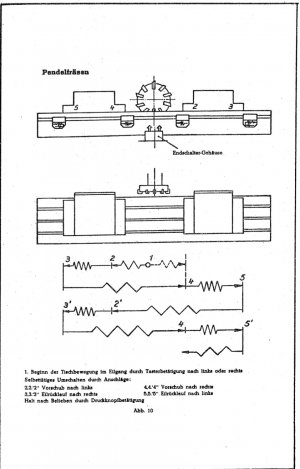Another beginner question about my horizontal 3k lbs knee mill (a Heckert Fw250), but applicable to countless other machines I think. The question is, when automatic milling with fast return how to prevent dragging a cutter across the work and breaking teeth? Or is it applicable only to some special cuts (and cutters) that are immune to it?
Let me explain what is meant by automatic milling.
My mill made in 1960s (estimated) has a feature of pre-CNC automatic milling. Only one axis can be under power at a time so it is all limited to a single axis. It is "programmed" by placing special plastic blocks on rails that each axis has one of. When the movement of the axis reaches that block it presses on limit switches in a special way engaging a certain function. The functions are divided into two groups. One works when approached from the left (and ignored from right) and the other opposite.
The functions are: stop feed, engage auto feed left or right, engage fast feed left or right. So not a lot of options, but the manual shows some examples how to use it(sorry it is in German, but understanding the text is not necessary).


So let's say you want to set up the work to mill down a surface on Z. You configure the mill to reach a certain spot on X, then return to it's start position. You can repeatedly press the button to start, auto feed starts on X milling your surface until it reaches your predetermined location. Then it fast returns to the start position. Then you move Z axis by hand up, press the button again and so on. You don't have to return manually.
There is a feature of this mill to lower the knee a tiny bit hydraulically, but it's an option my mill doesn't have. So the question is, is automatic milling useless without it? Or are you supposed to watch it like a hawk and lower the knee the moment it reaches the return point manually?
There is zero information about how to use this feature other than few drawings like ones I attached. Can anyone offer any more info?
Let me explain what is meant by automatic milling.
My mill made in 1960s (estimated) has a feature of pre-CNC automatic milling. Only one axis can be under power at a time so it is all limited to a single axis. It is "programmed" by placing special plastic blocks on rails that each axis has one of. When the movement of the axis reaches that block it presses on limit switches in a special way engaging a certain function. The functions are divided into two groups. One works when approached from the left (and ignored from right) and the other opposite.
The functions are: stop feed, engage auto feed left or right, engage fast feed left or right. So not a lot of options, but the manual shows some examples how to use it(sorry it is in German, but understanding the text is not necessary).


So let's say you want to set up the work to mill down a surface on Z. You configure the mill to reach a certain spot on X, then return to it's start position. You can repeatedly press the button to start, auto feed starts on X milling your surface until it reaches your predetermined location. Then it fast returns to the start position. Then you move Z axis by hand up, press the button again and so on. You don't have to return manually.
There is a feature of this mill to lower the knee a tiny bit hydraulically, but it's an option my mill doesn't have. So the question is, is automatic milling useless without it? Or are you supposed to watch it like a hawk and lower the knee the moment it reaches the return point manually?
There is zero information about how to use this feature other than few drawings like ones I attached. Can anyone offer any more info?
